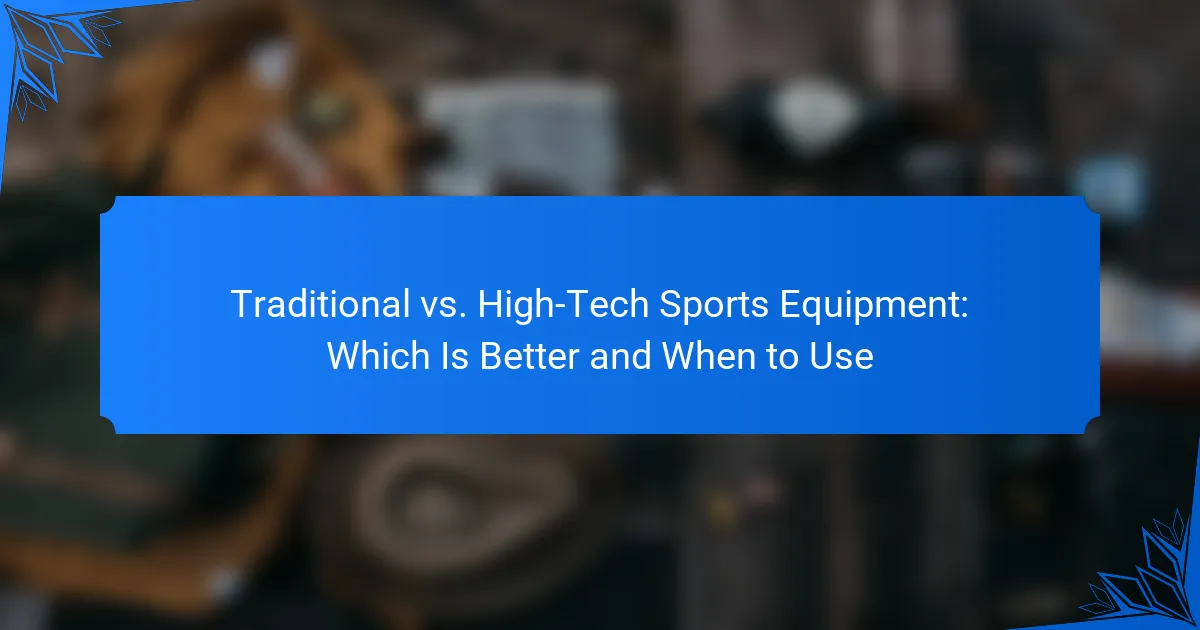When it comes to sports equipment, the choice between traditional and high-tech options can significantly impact an athlete’s performance and training experience. Traditional gear offers reliability and a focus on foundational skills, while high-tech equipment provides advanced features that can enhance performance and offer valuable data insights. Understanding the specific needs of the sport and the athlete’s goals is essential in making the right decision.

Which sports equipment is better for athletes in the UK?
Choosing between traditional and high-tech sports equipment depends on the athlete’s specific needs, sport, and level of competition. Traditional gear often offers reliability and familiarity, while high-tech options can enhance performance through advanced features.
Traditional sports equipment
Traditional sports equipment typically includes items like wooden bats, leather balls, and basic footwear. These products have been used for decades and are often preferred for their simplicity and durability. Athletes may find that traditional gear provides a sense of comfort and connection to the sport’s history.
For example, a classic wooden cricket bat is favored by many players for its balance and feel, despite the availability of modern composite alternatives. In sports like rugby and football, traditional leather balls are still popular for their performance in various weather conditions.
High-tech sports equipment
High-tech sports equipment incorporates advanced materials and technology to improve performance and safety. Items such as carbon fiber bicycles, smart tennis rackets, and GPS-enabled running shoes fall into this category. These products often feature data analytics to help athletes track their performance and make informed adjustments.
For instance, a smart tennis racket can provide real-time feedback on swing speed and impact location, allowing players to refine their technique. In cycling, high-tech bikes can reduce weight and enhance aerodynamics, giving competitive cyclists an edge.
Performance comparison
When comparing performance, traditional equipment often excels in providing a tactile experience, while high-tech gear can offer measurable enhancements. Athletes may find that traditional equipment allows for better skill development, as it often requires more technique and control.
Conversely, high-tech equipment can lead to improved performance metrics, such as faster speeds or greater accuracy. Athletes should consider their goals; for training, traditional gear might be beneficial, while competition may warrant high-tech options for optimal performance.
Cost considerations
Cost is a significant factor when choosing sports equipment. Traditional gear generally tends to be more affordable, with prices often ranging from low tens to a few hundred pounds. This makes it accessible for beginners or those on a budget.
High-tech equipment, on the other hand, can be considerably more expensive, sometimes costing several hundred to thousands of pounds. While the initial investment may be high, the potential for improved performance and longevity can justify the cost for serious athletes. It’s essential to weigh the benefits against the price to make an informed decision.

When should athletes use traditional sports equipment?
Athletes should consider using traditional sports equipment when focusing on foundational skills, budget constraints, or accessibility. These tools often emphasize technique and can be more cost-effective, making them suitable for various training environments.
Skill development
Traditional sports equipment is often designed to enhance fundamental skills. For example, using a wooden tennis racket can help players develop better hand-eye coordination compared to high-tech alternatives. This focus on basics is crucial for beginners or those looking to refine their technique.
Moreover, traditional gear typically lacks advanced technology that may distract from learning core skills. Athletes can concentrate on their form and strategy without the influence of performance-enhancing features found in high-tech equipment.
Cost-effectiveness
Traditional sports equipment is generally more affordable than high-tech options, making it a practical choice for many athletes. For instance, a basic pair of running shoes can cost significantly less than specialized footwear with advanced cushioning and tracking features.
Additionally, the lower price point allows athletes to invest in multiple pieces of equipment or upgrade more frequently. This can be particularly beneficial for schools or community programs with limited budgets.
Accessibility
Traditional sports equipment is often more widely available and easier to obtain than high-tech gear. Local sporting goods stores typically stock basic items like basketballs, soccer balls, and baseball gloves, making them accessible for athletes at all levels.
Furthermore, many community centers and schools provide traditional equipment for free or at a low cost, encouraging participation in sports. This accessibility helps foster a love for the game without the barrier of expensive technology.

When should athletes use high-tech sports equipment?
Athletes should consider using high-tech sports equipment when they seek to enhance performance, gain insights through data analysis, or prevent injuries. These advanced tools can provide significant advantages in training and competition, but they may also come with higher costs and a learning curve.
Performance enhancement
High-tech sports equipment can significantly improve an athlete’s performance by offering features like advanced materials and design. For instance, lightweight running shoes with carbon fiber plates can help sprinters achieve faster times. Athletes should evaluate the specific benefits of the technology against their sport’s demands and their personal goals.
When choosing performance-enhancing gear, consider factors such as weight, aerodynamics, and user comfort. Investing in equipment that aligns with your training regimen can lead to noticeable improvements, but it’s essential to test gear before making a purchase.
Data analysis capabilities
Many high-tech sports tools come equipped with data analysis features that track performance metrics like speed, heart rate, and technique. Wearable devices, such as smartwatches and fitness trackers, can provide real-time feedback, allowing athletes to adjust their training on the fly. This data-driven approach can lead to more informed decisions and better outcomes.
To maximize the benefits of data analysis, athletes should familiarize themselves with the technology and understand how to interpret the data. Setting specific, measurable goals can help in utilizing this information effectively, ensuring that the insights gained translate into improved performance.
Injury prevention features
High-tech sports equipment often includes injury prevention features, such as shock absorption and support systems. For example, specialized braces and footwear can help reduce the risk of common injuries like sprains and strains. Athletes should prioritize gear that offers these protective elements, especially during high-impact activities.
When selecting equipment for injury prevention, consider your sport’s specific risks and your personal injury history. Regularly assess your gear for wear and tear, as outdated equipment may not provide the necessary protection. Consulting with a sports professional can also help in choosing the right gear tailored to your needs.

What are the key differences between traditional and high-tech sports equipment?
Traditional sports equipment typically emphasizes simplicity and durability, while high-tech sports gear integrates advanced technology to enhance performance and user experience. Understanding these differences can help athletes choose the right equipment based on their specific needs and the context of their sport.
Material composition
Traditional sports equipment is often made from natural materials like wood, leather, or metal, which provide reliability and a classic feel. In contrast, high-tech equipment frequently utilizes synthetic materials such as carbon fiber, plastics, and advanced composites, which can offer lighter weight and increased strength.
For example, a traditional wooden tennis racket may weigh around 300 grams, while a modern composite racket can weigh as little as 260 grams. This difference can affect swing speed and player fatigue over long matches.
Technology integration
High-tech sports equipment often includes features like sensors, GPS tracking, and data analytics, which can provide real-time feedback and performance metrics. Traditional equipment lacks these technological enhancements, focusing instead on fundamental design and craftsmanship.
For instance, smart running shoes can track distance, speed, and even running form, allowing athletes to adjust their training accordingly. Traditional shoes, while effective, do not offer this level of insight.
Market trends
The market for high-tech sports equipment is growing rapidly, driven by consumer demand for enhanced performance and data-driven training. Traditional equipment still holds a significant place, particularly among purists and those who appreciate the craftsmanship and history behind classic designs.
Recent trends show that athletes are increasingly willing to invest in high-tech gear, with some spending hundreds to thousands of dollars on advanced equipment. However, traditional options remain popular for recreational athletes who prioritize affordability and simplicity.

How do athletes in the UK choose between traditional and high-tech equipment?
Athletes in the UK often weigh personal preferences and sport-specific requirements when deciding between traditional and high-tech sports equipment. The choice can significantly impact performance, comfort, and overall experience in their respective sports.
Personal preferences
Individual comfort and familiarity play crucial roles in selecting sports equipment. Some athletes may prefer traditional gear due to its simplicity and proven effectiveness, while others might gravitate towards high-tech options for their advanced features and performance enhancements.
For example, a runner might choose classic running shoes that offer a familiar fit, while another may opt for shoes equipped with smart technology that tracks performance metrics. Understanding one’s own preferences can lead to better satisfaction and performance.
Sport-specific requirements
Different sports have unique demands that can influence equipment choice. For instance, in sports like tennis, the choice of racket can depend on playing style, where traditional wooden rackets may appeal to purists, while modern composite rackets offer enhanced power and control.
Additionally, athletes should consider regulations and standards that may dictate equipment specifications. For example, in cycling, certain competitions may require adherence to specific gear limits, making high-tech options more suitable for competitive scenarios.
